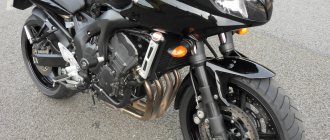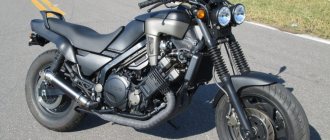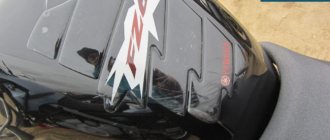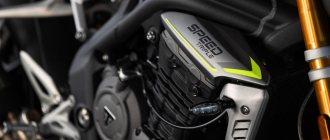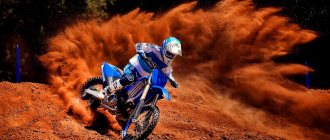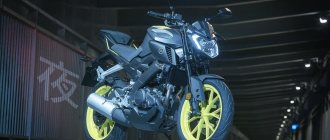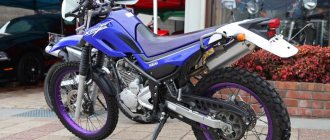What does this model have in common with the VMX 1200 from Yamaha? Nothing but its purpose - to squeeze everything out for the sake of speed. These bikes will appeal to lovers of a bright, aggressive riding style. The Yamaha FZX 750 Fazer is an extremely controversial motorcycle, but hardly anyone, having met the model, remained indifferent.
Firstly, its design catches your eye. The angular, from some point of view even rough, but very effective and distinctive exterior immediately sets the car apart from other representatives of the road class. Secondly, a motor that simply glows with an inexhaustible desire to demonstrate its character. It is clear that such a motorcycle is not suitable either in terms of displacement or dynamics and is even contraindicated for a beginner.
Specifications
In short, this is an archaic-looking monster that can leave many modern pompous classmates behind on the track. In appearance, it is not even presentable, especially when compared with modern aesthetic models, adjusted to the last bend. But the filling here is simply brutal, and the main advantage of the Yamaha FZX 750 Fazer is, of course, the engine.
Phaser: a moment of history
The Yamaha FZX 750 was produced from 1986 to 2000 , but the first generation is considered the most canonical, the last representatives of which rolled off the assembly line in 1990. It featured a more powerful engine ( 96 hp in European versions and 77 in Japanese) and 6-speed transmission, but the peak torque for the “Europeans” was reached only at 8000 rpm , and for the “Japanese” - at 6000 rpm min . Monstrous acceleration dynamics combined with the simplicity and reliability of the design gave the first generation Yamaha FZX 750 the status of a cult motorcycle.
Starting in 1990 , minor changes were made to the design - the engine was “ strangled ,” the gearbox was changed to a 5-speed , and in general they tried to turn the dragster into a road bike. It should be noted that representatives of the second generation, adjusted to Japanese standards, can easily compete with sports motorcycles on the road, but, nevertheless, it is the first “Phasers” that are still loved by enthusiasts. For obvious reasons, finding such a bike in good condition is problematic - they are all thirty years old, give or take.
Dimensions and weight
The volume of the gas tank is 13 liters, but the actual consumption can be as low as 6 liters per hundred kilometers or as much as 9 liters. The weight of the model including a fully filled fuel tank is 226 kg. The seat height here is 750 mm, which makes the motorcycle a suitable option if the rider is not tall.
Pros and cons of the Yamaha FZX 750 Fazer
Advantages
- Crazy acceleration dynamics. When the gas is sharply opened, the motorcycle literally jumps out from under the pilot, trying to move towards the horizon in a matter of seconds. The Yamaha FZX 750 can easily leave many modern bikes in the dust.
- Decent brakes. In those years, of course, no one had heard of combined braking systems and ABS, but for such an old motorcycle, the brakes on the Yamaha FZX 750 are really quite good.
- Comfortable fit. Thanks to thoughtful ergonomics and moderately compact dimensions, the Yamaha FZH 750 is suitable for most bikers.
- 6-speed transmission (first generation). On long trips, according to reviews, it allows you to save a lot of fuel if you don’t drive too fast.
- Vitality. The simple design of the FZH 750 is distinguished by its reliability and ease of repair; it can be serviced in the garage, and repaired on the knee. If you take good care of it, it will serve faithfully for a very long time.
Flaws
- Wind protection. The FZX 750 does not have it, from the word “at all,” so the headwind begins to blow away from the motorcycle already at 130-140 km/h.
- Fuel consumption. The consumption declared by the Japanese when releasing this motorcycle was about 2.4 liters (!) per 100 mph. It is not known exactly how they measured it, but on average, real gasoline consumption ranges from 5.5 (with quiet driving on the highway) to 10 liters of AI-92 (city traffic jams, crazy runs on the highway at speeds under 200 km/h).
- Small gas tank capacity - only 13 liters .
- Valency. It’s not easy to control a motorcycle at low speeds—it reacts very sharply to opening the gas, and also regularly tries to fall on its side in a turn. But once you reach at least 30 km/h, this drawback goes away.
- Headlight. It shines weakly, but replacing the bulb with a more powerful one helps somewhat.
Chassis and brakes
Since this bike has sporting roots, this could not but be reflected in the suspension features. They are downright stiff, which, of course, makes the motorcycle completely unsuitable for rough roads and off-road conditions. But on a good track, the FZX 750 Fazer will be able to please you with its handling, on par with many top representatives of the sports class.
Despite the fact that the rear brake here is quite reliable, because, firstly, it is a disc, and secondly, it is helped by a two-piston caliper, in general the braking system cannot be called sufficient due to the small diameter of the front two discs , equal to 267 mm.
The secret to the success of the FZX 750
The Yamaha V-Max 1200 was not very cheap, so they decided to simplify the FZX to reduce its cost. A 20-valve, 4-cylinder liquid-cooled engine was inserted into a tubular steel frame, and the wheel drive was made to be a chain drive, considering that the cardan would make the structure more expensive and heavier. They didn’t think much about the design, having come up with a certain average look for this motorcycle with recognizable features of its “big brother” - the V-Max. The square headlight looks archaic, but stylish in its own way - this design element immediately makes the Yamaha FZX stand out in city traffic. It’s a pity that it shines so-so, but what can you expect from light optics developed in the mid-80s of the last century? But the overall silhouette with chopped straight lines turned out to be brutal and generally interesting.
The full-power European version accelerates to 100 km/h in 3.2 seconds , and the Japanese version in 4. At the same time, the maximum speed is 220 and 180 km/h , respectively. The weight of the bike is about 225 kg , but it doesn’t seem heavy - the engine located in the frame at an angle shifts the center of gravity down, so subjectively the bike seems quite light. It is not deprived of suspensions - both the front and rear shock absorbers are equipped with pumping, which allows them to be adjusted, in addition, the rear shock absorbers have the standard ability to set the required pretension. Although it must be admitted that the Yamaha FZH 750 accelerates much better than it handles - at high speed the motorcycle turns into a cannonball, which is difficult to force to change its trajectory. Well, what did you want - it’s a dragster! Fortunately, its brakes are passable - 267 mm brake discs all around, with 2-piston calipers (2 discs on the front wheel and 1 on the rear).
Summary
Yamaha FZX 750 Fazer is a living archaism, a guest from the past. In those years when it was created, manufacturers did not particularly think about safety, ecology and other side issues that now rule the roost. They set themselves the goal of creating an affordable, powerful motorcycle, and they coped with this task one hundred percent. If the Yamaha FZH 750 was produced today, it would certainly find its buyers, but, alas, it was discontinued twenty years ago... However, you could find a “live” bike, if you wanted to. In caring hands, the ancient “Phaser” will serve for many years, and even many modern sportbikes cannot give as much adrenaline as it can handle. Now, alas, such remarkable models are no longer made - marketers have defeated engineers and designers, and the FZX 750 is a brutal iron symbol of a bygone era.
Specifications
| Maximum engine power: | 77 - 96 HP |
| Torque: | 70.0 - 76.5 Nm |
| Working volume: | 749 cm3 |
| Motor type (cylinder arrangement, number of strokes): | 4-cylinder, 4-stroke, in-line |
| Number of cylinders: | 4 |
| Number of valves: | |
| Intake type (Injector / Carburetor): | |
| Bore and stroke: | |
| Starting system (Electric starter, kick starter): | |
| Maximum speed in km/h: | 220 km/h |
| Cooling system: | Liquid |
| Transmission (gearbox): | Mechanical 6-speed |
| Clutch (Dry / Wet): | |
| Drive unit: | Chain |
| Frame: | Steel tubular |
| Chassis | |
| Suspension (front/rear travel): | |
| Brakes (Front/Rear): | |
| Wheels / Tires / Rubber: | |
| Dimensions and weight | |
| Dimensions (Length / Width): | |
| Seat height: | |
| Ground clearance: | |
| Curb weight: | |
| Wheelbase: | 1530 mm |
| Weight: | 226 kg |
| Fuel tank capacity: | 13 l. |
| Battery capacity: | |
| Year of release: | |
| Country of Origin: |
Main competitors
- Honda X4. This bike is a rival firm's attempt to create a rival to the Yamaha FZX 750 and V-Max by using a reworked engine from the Honda CB 1300 Super Four. The bike turned out to be very interesting, but it failed in sales, as a result of which it was quickly discontinued.
- Honda V45 Magna 750. Power cruiser with impressive performance. What it has in common with the Yamaha FZH 750 is the combination of frantic dynamics and mediocre handling, especially at high speed. This especially applies to representatives of the first generation of Honda. Due to its advanced age, finding a Magna in decent condition is no easier than finding an FZX 750.
Owner reviews
Before purchasing, I read reviews about the Yamaha FZH 750, people are generally satisfied. The prices for this model are low due to its antiquity; you can buy it for the same money as some 400 seabird, which didn’t even stand next to the Phaser. Yes, the bike is old, with all the ensuing consequences, but it’s reliable as a brick, and there are no problems with spare parts; many things fit from other models. It accelerates like a rocket, it consumes gas like crazy, although I may not be objective here, because... My carbs are not original, and I don’t know what’s in them. In general, a really crazy lighter for little money. Vadim, Moscow, Yamaha FZX '1988.
I was inspired to buy this motorcycle when I looked at a review of it on YouTube, although at that time there was already a Dragstar 1100 in the garage. I ended up taking it from a friend for 110k, 1990, 60k mileage on the odometer (but that’s not certain). Over the course of a month, I tidied up the little things, rode either it or the Drag, depending on my mood. This motorcycle is designed to rock, I think most owners will agree with me here. I drove it for a year, got hooked, sold it, bought a V-Max 1200 from the last year of production. The same as FZH 750, only better. Alexander, Novosibirsk, Yamaha FZX 750 '1990
The Phaser has two disadvantages - age and gas tank volume, the rest are pure advantages. If you find a non-killed copy, it will serve faithfully, all consumables are there, spare parts can be found. A bike for centuries, they don’t make them like that anymore. Ilya, Moscow, Yamaha FZX 750 '1994.
